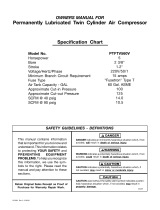
DESCRIPTION OF OPERATION
Air Compressor Pump: To compress air, the piston
moves up and down in the cylinder. On the downstroke,
air is drawn in through the air intake valves. The exhaust
valve remains closed. On the upstroke of the piston, air
is compressed. The intake valves close and compressed
air is forced out through the exhaust valve, through the
outlet tube, through the check valve and into the air tank.
Working air isnot available untilthe compressor has raised
the air tank pressure above that required at the air outlet.
Check Valve: When the aircompressor is operating, the
check valve is "open", allowing compressed air to enter
the air tank. When the air compressor reaches "cut-out"
pressure, the check valve "closes", allowing air pressure
to remain inside the air tank.
Pressure Release Valve: The pressure release valve
located on the side of the pressure switch, is designed to
automatically release compressed air from the compres-
sor head and the outlet tube when the air compressor
reaches "cut-out" pressure or is shut off. If the air is not
released, the motor will try to start, but will be unable to.
The pressure release valve allows the motor to restart
freely. When the motor stops running, air will be heard
escaping from the valve for a few seconds. No air should
be heard leaking when the motor is running.
Pressure Switch: The pressure switch automatically
starts the motor when the air tank pressure drops below
the factory set "cut-in" pressure. It stops the motor when
the air tank pressure reaches the factory set "cut-out"
pressure.
Shut-offValve: Turn the knob counter-clockwiseto open
the valve and clockwise to close.
Safety Valve: If the pressure switch does not shut off the
air compressor at its cut-out pressure setting, the safety
valve will protect against high pressure by "popping out"
at its factory set pressure (slightly higher than the pressure
switch cut-out setting).
Regulator: The air pressure coming from the air tank is
controlled bythe regulator knob. Turn the knob clockwise
to increase pressu re and cou nter-cloc kwise to decrease
pressure. To avoid minor readjustment after making a
change in pressure setting, always approach the desired
pressure from a lower pressure. When reducing from a
higher to alower setting, first red uceto some pressure less
than that desired, then bring up to the desired pressure.
Depending on the air requirements of each particular
accessory, the outlet regulated air pressure may have to
be adjusted while operating the accessory.
Outlet Pressure Gauge: The outlet pressure gauge
indicatesthe air pressure available at the outlet side of the
regulator. This pressure iscontrolled bythe regulator and
is always less or equal to the tank pressure. See
"Operating Procedures".
Tank Pressure Gauge: The tank pressure gauge indi-
cates the reserve air pressure in the tank.
Flow Valve: This compressor may contain a flow valve
which blows air for approximately 10 seconds. This is
normal and helps the compressor start or restart easily.
Cooling System: This compressor contains an advanced
design cooling system. At the heart of this cooling system
is an engineered fan. It is perfectly normal for this fan to
blowair through thevent holes inlarge amounts. You know
that the cooling system is working with air is being
expelled.
TOOLS NEEDED FOR ASSEMBLY
• an adjustable wrench for attaching the pressure regulator
• a 9/16" socket or open end wrench for attaching the wheels, wheel plates and hose adapter.
• a 7/16" open end wrench for attaching the air pressure gauges
• a 3/16" hex key for installing the plug in the regulator
• a 3/8" open end wrench to tighten handle screws
• a #2 Phillips screwdriver for attaching the control cover
• a 3/8" socket wrench for removal of shipping boards and installation of rubber feet
• a 9/16" socket or open end wrench for attaching the hose adapter.
• a 7/16" and 9/16" open end wrench for attaching the air pressure gauges














